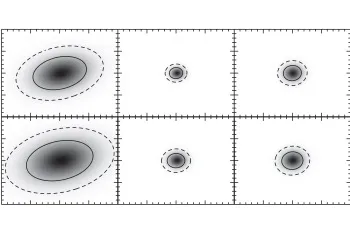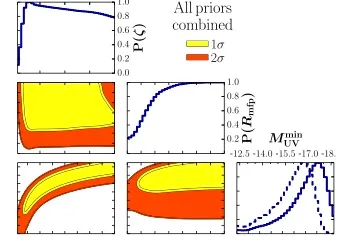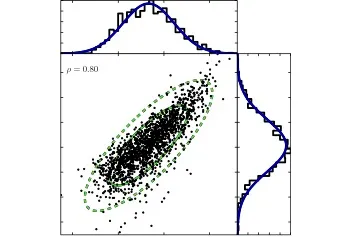I have worked on numerous research projects througout my academic career that cover a broad variety of subjects. Below I have broadly classified these projects into their own research topics. For each of these projects I provide a brief description for each of the main projects, which links to the main journal publication. The four major research areas are:
RESEARCH
Studying the EoR by mapping the neutral hydrogen between galaxies
Observing the galaxies responsible for causing the Epoch of Reionisation
(EoR) is extremely difficult due to how faint these galaxies are and how expensive
it is to observe them. Alternatively, we can infer how these galaxies caused
reionisation by observing how quickly the neutral hydrogen in the almost empty
space between galaxies disappears due to the ionising radiation they emit. This
can be observed by detecting the 21-cm hyperfine line of neutral hydrogen, which
is redshifted to be observed at radio frequencies. For this, I wrote 21CMMC
which uses Bayesian inference to interpret real or synthetic observations to reveal
insights into the physical properties of the galaxies responsible for reionisation.
21CMMC performs 3D realisations of the 21-cm signal using the 21cmFAST
simulation software on-the-fly within a Monte-Carlo Markov-Chain (MCMC).
Exploring all things 21-cm related was the dominant focus of my research career,
thus these projects can be broken down into the following smaller sub-categories:
Exploring alternative statistical methods for measuring the 21-cm signal
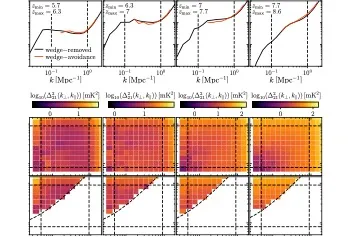
Inferring astrophysical parameters using the 2D cylindrical power spectrum from reionisation
Using simulation-based inference to demonstrate the improvements in constraints on our astrophysical model parameters that are achievable due to the additional spatial information present when we compress the 3D signal down to a 2D summary statistic (cylindrical power spectrum) compared to a simple 1D PS.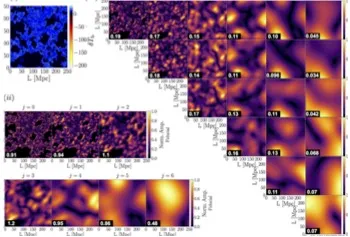
Exploring the cosmic 21-cm signal from the epoch of reionization using the wavelet scattering transform
Introducing a new summary statistic analogous to performing a convolutional neural network to extract non-Gaussian information about the neutral hydrogen. Apply a series of wavelet filters of varying length scales and compress the information into a series of scattering coefficients. This is applied directly to 2D images.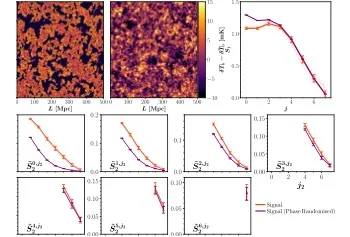
Detecting the non-Gaussianity of the 21-cm signal during reionization with the wavelet scattering transform
A neat idea by my colleague to detect the presence of the non-Gaussian aspects of the 21-cm signal from neutral hydrogen by taking the ratio of the scattering coeffients extracted from the true 2D image compared to those from a 2D image with the phase information removed. Amplitudes above zero imply non-Gaussian signal in the original image.Interpreting observational data
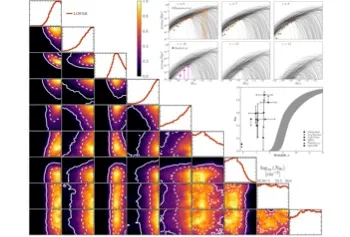
Interpreting LOFAR 21-cm signal upper limits at z ≈ 9.1 in the context of high-z galaxy and reionization observations
Using the best upper-limits on the 21-cm signal from the LOFAR radio interferometer to interpret what this signal can tell us about the physics of reionisation. Achieved by performing Bayesian inference to search for models in excess (disfavoured) by the upper-limits.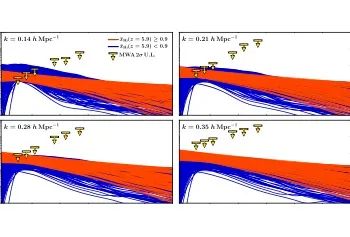
Exploring reionization and high-z galaxy observables with recent multiredshift MWA upper limits on the 21-cm signal
Using the best upper-limits on the 21-cm signal, but instead from the MWA radio interferometer. Perform the same analysis searching for disfavoured models but at a different period during the EoR.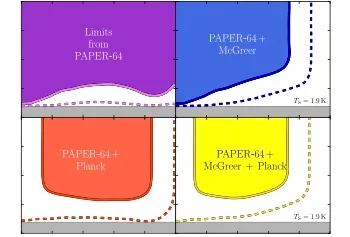
Constraints on the temperature of the intergalactic medium at z = 8.4 with 21-cm observations
Using upper-limits on the 21-cm signal from the PAPER-64 radio interferometer to recover a minimum temperature for the neutral hydrogen during the EoR. Inferred a temperature in excess of 3 K, implying some level of heating of the neutral hydrogen due to ongoing reionisation.Developing the 21CMMC framework
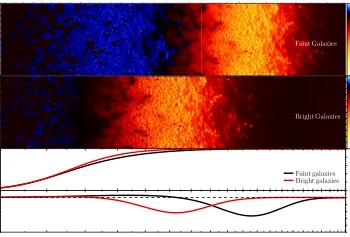
21CMMC with a 3D light-cone: the impact of the co-evolution approximation on the astrophysics of reionization and cosmic dawn
Further expanding the capabilities of 21CMMC to include 3D light-cones of the neutral hydrogen, enabling 21CMMC to better match the characteristics of observational data.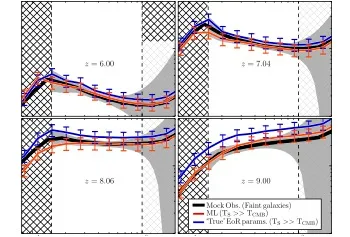
Simultaneously constraining the astrophysics of reionization and the epoch of heating with 21CMMC
Exanding 21CMMC to explore the full evolution of the 21-cm signal including the heating of the neutral hydrogen due to X-rays emitted by the first galaxies.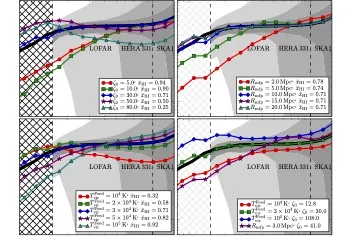
21CMMC: an MCMC analysis tool enabling astrophysical parameter studies of the cosmic 21 cm signal
The introductory publication of 21CMMC, showcasing for the first time the ability to perform 3D simulations of reionisation within a Bayesian inference pipeline.Forecasting for the Square Kilometre Array
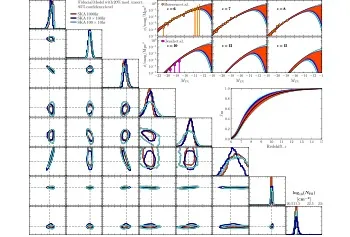
Reionization and cosmic dawn astrophysics from the Square Kilometre Array: impact of observing strategies
The Square Kilometre Array is set to revolutionise what we can learn about reionisation. This explores optimal survey designs to maximise the available information we can extract given a fixed amount of observing time.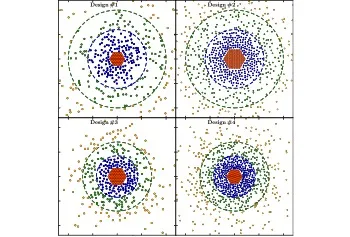
Optimal core baseline design and observing strategy for probing the astrophysics of reionization with the SKA
The first phase of the Square Kilometre Array underwent descoping of the original design due to budget limitations. This project explored the consequences of these proposed changes to determine which minimised the impact of the actual intended science on the EoR.Understanding the 21-cm signal from the neutral hydrogen
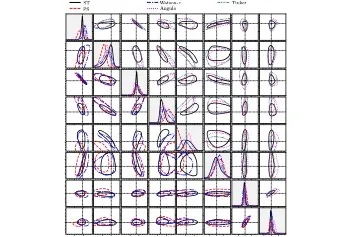
Exploring the role of the halo mass function for inferring astrophysical parameters during reionisation
Our inference pipelines make many simplifying assumptions which can bias what information we extract from an observation. Using simulation-based inference I explored how assuming a fixed functional form for the number density of galaxies can lead to significant biases and that these can be removed if we instead simultaneously fit a generalised functional form.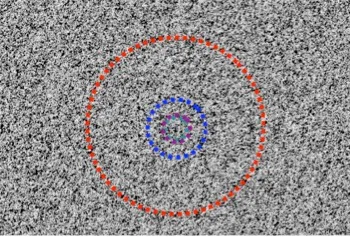
Generating extremely large-volume reionization simulations
To perform accurate end-to-end validation of radio interferometer data analysis pipelines, we require simulations in excess of the instrument field-of-view. This can be extremely computationally challenging. Using a simplified version of 21cmFAST I created a 8 Gpc wide simulation, more than 4 times larger than anything previously.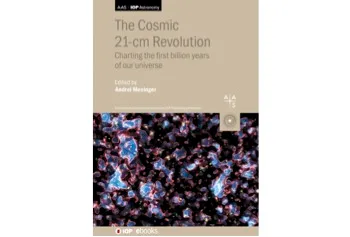
Inference from the 21cm signal
This is textbook chapter I wrote in 2019 summarising the current state-of-the-art in extracting astrophysical information about the EoR from observations. It explored various summary statistics of the signal and what unique insights each provided along with discussions on the various inference methodologies in use.Using how bright objects are partially obscured due to neutral hydrogen from the EoR
The observed Lyman-alpha emission line of high-redshift quasars during the
EoR can be attenuated due to the neutral hydrogen present in the space
between galaxies. By reconstructing the true, unattenuated profile one can
compare the level of attenuation against numerical simulations to estimate
the average neutral hydrogen that persists along the line-of-sight.
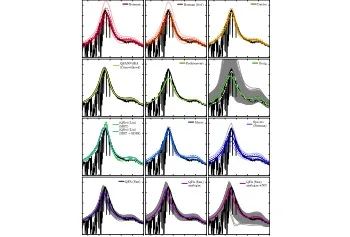
Blind QSO reconstruction challenge: Exploring methods to reconstruct the Lyα emission line of QSOs
A comparison of the performance of ten different Lyα reconstruction pipelines for the same unified set of QSOs. The study was performed blind to minimise confirmation bias. Provided both a qualitative and quantitative comparison.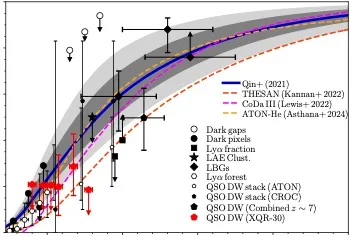
IGM damping wing constraints on the tail end of reionization from the enlarged XQR-30 sample
The most comprehensive analysis of high redshift QSOs to interpret constraints on the EoR. Using a carefully selected sample of 23 QSOs observed with X-Shooter as part of the XQR-30 campaign, constraints on the EoR were determined between 5.8 < z < 6.5.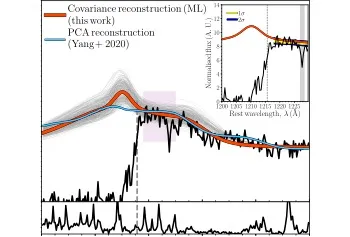
IGM damping wing constraints on reionization from covariance reconstruction of two z ≥ 7 QSOs
Obtained constraints on the EoR using two new observed z > 7 QSOs. Applied the updated reconstruction pipeline to recover constraints on the neutral fraction. Additionally, performed a comparison to existing constraints from a PCA based reconstruction pipeline.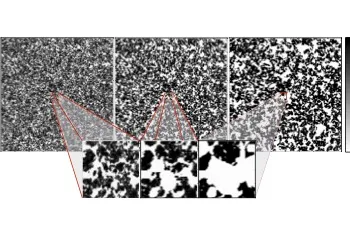
Constraints on reionization from the z = 7.5 QSO ULASJ1342+0928
Extracting constraints on the EoR using the observed spectrum of the QSO with the record for the highest redshift at the time. Expanded the reconstruction pipeline to simultaneously reconstruct the N V emission line. Applied the same analysis pipeline to recover constraints on the neutral fraction.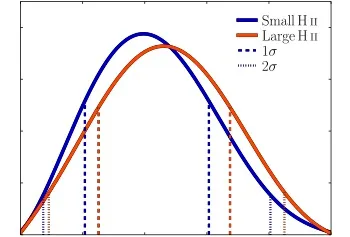
Are we witnessing the epoch of reionisation at z = 7.1 from the spectrum of J1120+0641?
The first measurement of on-going reionisation. Obtained by comparing the observed spectrum of the first ever z > 7 QSO to the predicted Lyα emission line from my Bayesian reconstruction pipeline. These are then compared against EoR simulations to determine how much neutral hydrogen is needed to explain the attenuation of the observed spectrum.Tracing gas between galaxies to measure how much dark matter and dark energy exists
QSOs are amongst the brightest individual objects, acting as intense beacons shining their light over the vast distances between us and the QSO. The emitted
light gets redshifted as it travels through the expanding space with its wavelength getting longer (frequency getting shorter) the further it travels. If this light
redshifts into resonance with the absorption frequency of neutral hydrogen, it will be absorbed and rescattered away from us. Doing so leaves a characteristic absorption
trough in the observed spectrum indicating the presence of small clouds of neutral hydrogen between us and the QSO. This only happens long after the EoR, once most of the
neutral hydrogen has been ionised with these clouds sufficiently dense to have withstood the intense radiation during the EoR. The series of absorption troughs tracing these
clouds of neutral hydrogen are known as the Lyα forest.
If we observe a sufficiently large number of these QSO sightlines through the Universe, we can build a map of where all these clouds of neutral hydrogen are distributed.
Doing so over sufficiently large volumes of the Universe, we can measure a characteristic length scale arising due to Baryon Acoustic Oscillations (BAOs). These are sound
waves in the primordial plasma left over after the Big Bang which caused matter to cluster together with a slightly higher probability than random. Measuring this scale
to sufficienctly high precision (which requires large volumes of space to be probed) allows us to "weigh" the amount of dark matter and dark energy as the Universe expands.
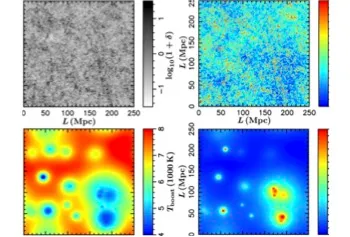
The impact of temperature fluctuations on the large-scale clustering of the Lyα forest
Helium, like hydrogen also undergoes reionisation, but this occurs much later, right when we want to use the Lyα forest for studying these BAOs. I modified my Lyα forest simulations to explore the impact of the heat injected into the neutral hydrogen due to Helium reionisation.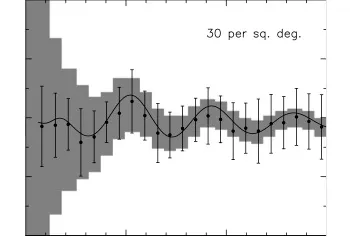
Fast, large-volume, GPU-enabled simulations for the Lyα forest: power spectrum forecasts for baryon acoustic oscillation experiments
This was my first research project. I wrote simulations to use the computational power of Graphics Processing Units (GPUs) to produce large volumes of the Universe to statistically study the recovery of the BAOs from the Lyα forest.Observing large numbers of galaxies to figure out how much dark matter and dark energy there is
Galaxies, like QSOs also emit Lyα radiation. However, they are much fainter making it difficult to measure an equivalent Lyα forest. However,
galaxies are also considerably more numerous. If we observe large numbers
of Lyα emitting galaxies (LAEs), and know their precise locations we can estimate how these cluster together on large scales. Doing so once
again allows us to measure the BAOs. However, because we are selecting these galaxies based on their Lyα emission, estimating the clustering
strength of these galaxies becomes complicated due to additional radiative transfer effects. Thus more traditional statistical measurements such as
two-point correlation functions (statistical distribution of pairs of galaxies separated by their distance) do not contain enough unique information
to separate out the cosmological effects due to dark matter and dark energy
from the degenerate radiative transfer effects. Thus we need to consider more complicated, higher order statistical methods.
